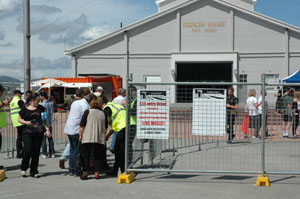
The 6th Tasmanian Beerfest
I still have fond memories of the first Hobart Beerfest, held in November 2006. It was a low-key and informal event, as far as such things can be, held outdoors in Mawson Place behind the Lark Distillery. The Beerfest has grown greatly since then, becoming a two-day event in 2009, and the sixth annual festival, held last month at Princes Wharf no.1 shed, had a distinctly militaristic feel to it. I found the 6-foot steel fences surrounding the venue, the ever-present security guards, and the compulsory wrist bands, on top of the $30 entry fee, to be somewhat intimidating, but I overcame my reservations and braved a visit on opening day, Friday 18 November.
 Entry was smooth and straightforward, perhaps an advantage of the militaristic gate arrangements, and once inside the shed my first task was to reconnoitre the venue and to plan my attack on the beer stalls. There were several stalls purveying solid food, and I counted a further twenty-seven liquid food stalls, comprising five Tasmanian microbreweries, one Tasmanian meadery, the two large Tasmanian breweries (Cascade and Boag), nine interstate brewers and cidermakers, and ten stalls devoted to various foreign beers and ciders. My primary target was the local, Tasmanian breweries.
Entry was smooth and straightforward, perhaps an advantage of the militaristic gate arrangements, and once inside the shed my first task was to reconnoitre the venue and to plan my attack on the beer stalls. There were several stalls purveying solid food, and I counted a further twenty-seven liquid food stalls, comprising five Tasmanian microbreweries, one Tasmanian meadery, the two large Tasmanian breweries (Cascade and Boag), nine interstate brewers and cidermakers, and ten stalls devoted to various foreign beers and ciders. My primary target was the local, Tasmanian breweries.
Rain soon proved the sense of holding the event at a covered venue (the 2009 festival was the first to be held in the wharf shed), although it did less than nothing to justify the high entry fee—part of which, I was assured, was to cover the cost of the live music, performed outdoors to empty seats when the rain was falling. My main task being to gather intelligence, the music was neither here nor there. I set to work.
Happily, most of the Tasmanian microbreweries were represented, the only notable absence being the Two Metre Tall Company of New Norfolk. Those that did participate were: Moo Brew (Bridgewater), Iron House Brewery (near St Mary’s), Van Dieman Brewing (Evandale), Seven Sheds (Railton), and the very new Morrison Brewery (Launceston). The latter, a small, family-owned business, launched its products at this year’s Beerfest, just as Iron House had done at the 2007 event, and Van Dieman in 2009.
Also present was Taverner’s Products, which calls itself a microbrewery, and calls its products ‘ale’, although it is in fact a meadery. Mead is rare in Australia, compared to beer, and even compared to cider, but that seems to me to be no reason not call it by its proper name. In the same vein, I note with dismay that some Australian makers of perry are calling their products ‘pear cider’, but that is another story.
After sampling products from all of the local (Tasmanian) producers, except for the foreign-owned Cascade and Boag breweries which I ignored, my attention turned next to several from interstate. These included Mountain Goat, 2 Brothers and White Rabbit (Victoria), 4 Pines, Malt Shovel, Bluetongue and McLaren Vale (New South Wales), Little Creatures (Western Australia), and Three Oaks (a South Australian cider maker).
Matilda Bay, which also had a stand, cannot easily be assigned to a state. It originated in Western Australia, and now is notionally based in Victoria, but most of its beer is made at the Cascade plant in Hobart, so it probably qualifies as another Tasmanian brewer. Both Cascade and Matilda Bay are now Australian brewing assets of the multi-national SAB Miller, and this is reflected in the fact that Cascade and Matilda Bay occupied adjoining stalls at the Beerfest.
I should also explain that, although I have assigned the McLaren Vale company to New South Wales, where its beer is presently made, it will soon have its own brewery operating in South Australia. Bluetongue, a New South Wales brewery, operated the ‘Peroni’ stall, where it was mostly concerned with promoting its Australian-made versions of Peroni, Grolsch, and Miller beers, although its home-grown brand, Bluetongue Lager, was also on offer.
The Tasmanian Beerfest bills itself as ‘Australia’s largest beer festival’, but the rationale for this is not explained. Does it attract the most visitors? The most exhibitors? Or does it have the greatest variety of beers available for tasting? If the latter, then a great proportion of the extensive drinks menu is attributable to the several foreign beer (and cider) importers and distributors who took stalls at the event. The foreign line-up, too numerous to detail here, gives rise to the alternative name for the event—Tasmanian International Beerfest.
As you might imagine, my ten tasting vouchers (included as part of my $30 entry entitlement, along with a tiny plastic tasting cup, into which much tinier samples of beer were served), were soon expended. Happily, I thought at first, it was also possible to purchase full-sized cups of beer from many of the exhibitors, for prices that ranged around five or six dollars for a schooner of Australian draught beer. This opportunity, however, might easily have turned my visit from an intelligence-gathering exercise to an all-out piss-up. I restrained myself, and limited my further intake to just a few full drinks. Satisfied, I left Beerfest 2011 at 8pm, after three hours of research. I do not know what transpired from then until closing time—11pm—but I can easily imagine that had I remained until then I might have come to understand the need for the fences and security guards about which I had earlier complained.
[adrotate group=”1″]



